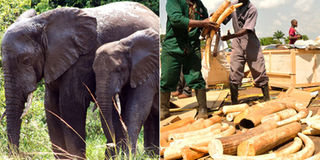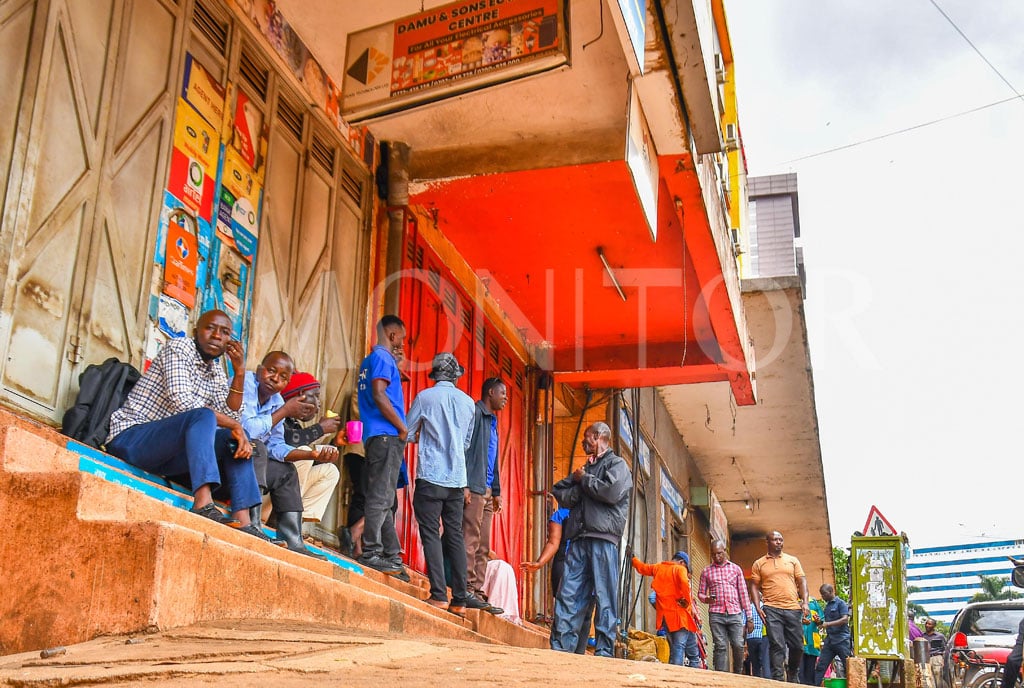Who will save the African giant?

Elephants in Queen Elizabeth National Park. Left: Uganda Wildlife Authority law enforcement officers and police check some of the ivory impounded at Entebbe International Airport recently. According to Aviation police commander Lodovick Awita, the ivory was worth Shs1.1 billion. He said the smugglers also had five boxes containing pangolin scales worth Shs2 billion. PHOTOS BY Edgar R Batte/ Machael Kakumirizi
What you need to know:
Endangered. Due to the increasing demand for wildlife products, including ivory, animals such as elephants, risk extinction if nothing is done to check this trend.
A recent study published in the US Proceedings of the National Academy of Sciences journal indicated that about 100,000 elephants were killed in the last four years globally.
The International Union for Conservation of Nature (IUCN) estimated that the elephant population across the African continent had dropped from 550,000 in 2006 to 470,000 in 2013. It attributed the drop to mainly poaching and environmental degradation.
Fortunately, statistics from Uganda Wildlife Authority (UWA) indicate that elephant population for Queen Elizabeth Protected Area has gradually increased from 400 in 1988 to 2,959 in 2010, while in the same period in Murchison Falls Protected Area, the large mammals have too increased from 201 in 1995 to 904 in the same period.
In the same period, the population of Buffaloes has increased from 2,477 to 9,192, that of giraffes from 153 to 930 and Hartebeests from 2,431 to 3,589 due to several factors, including stability in the country, strict conservation measures and general awareness among the population.
These wildlife crimes not only threaten the existence of different species and the tourism sector, but also national security as gangs and other terrorist organisations use this as an avenue to get funding to facilitate their activities.
And indeed, an estimated illegal wildlife products worth more than Shs5 billion was seized last year, according to the Tourism, Wildlife and Antiquities minister, Ms Maria Mutagamba.
Speaking at the Illegal Wildlife Trade Conference in Botswana‘s northeastern town of Kasane, Ms Mutagamba said illegal killing of elephants and its trade has derailed the continent’s tourism sector, which of recent, is turning out to be a backbone of foreign exchange earnings for most African countries.
Uganda’s tourism sector contributed 7.9 per cent of the country’s Gross Domestic Product in 2013 translating into Sh5.5 trillion and created more than 500,000 jobs. Despite this contribution, the sector got just close to Sh800 million as its investment in the same Financial Year.
“In just one year, we have seized more than two tonnes of Ivory [estimated to be worth about Shs2.2 billion], 30 Rhino horns and about two tonnes of Pangolin scales [worth about Shs2.9 billion] at Entebbe International Airport. We are determined to make it increasingly difficult for wildlife traffickers to use Uganda as a transit country,” Ms Mutagamba said.
The country is not only a transit area for the valuable wildlife products but has too experienced the same crimes.
UWA executive director Andrew Seguya, who was part of Minister Mutagamba’s contingent, said Uganda has been successful in arresting large consignments of wildlife contraband because of surveillance.
“We have an intelligence service of 80 officers and a plethora of informers” across border points and around game reserves.
However, there is more that needs to be done to stamp out the vice, he said. According to Ms Mutagamba, Uganda has experienced some few challenges in the management of the national ivory stockpile to the extent that about 1.2 tonnes of ivory was lost in 2014.
Last year, an audit by UWA found that 1,300 kilogrammes of ivory worth $1.1m (about Shs3b) was missing, consequently attracting the attention of President Museveni, who asked the Inspector General of Government to investigate the matter. The IGG’s report is yet to be released.
Early this month, China, the world’s largest ivory importer, imposed a one-year ban on ivory carving imports. Ivory is a highly prized commodity in markets such as Malaysia and China as it is a sign of prestige and wealth. From ivory, magnificent sculptures are made. With the increase in incomes by the Chinese, the demand for ivory has increased in the past years, leading to the killing of thousands of elephants in Africa.
Mutagambwa said the Uganda will continue to use the accredited forensic laboratories in USA and South Africa to determine in ascertaining the origin of seized ivory and rhino horns. She however said “Uganda welcomes the establishment of the new forensic laboratory in Nairobi and we will definitely make use of it,”
At the same conference, Minister Mutagambwa accepted to join the Elephant Protection Initiative (EPI), but asked for funding that will enable the implementation of the African Elephant Action Plan. Botswana President, Lt Gen Khama Ian Khama, said wildlife poaching and trafficking had indeed reached unmatched levels throughout the world, especially with endangered species.
THE CONFERENCE
The conference that brings together flora and fauna conservationist from Africa, took place on March 25 in Botswana and sought a ban on the marketing of illegal wildlife and strengthening law enforcements. The conference is a follow up on the 2013 meeting, where 30 countries adopted several conservation measures, including a call to unite against poaching and for improved criminal prosecution.
The continent representative at the conference resolved to “conduct and, or support research to improve understanding of market drivers, strengthen, and if necessary, establish partnerships among source, transit and destination countries to combat the illegal wildlife trade along its entire chain, ensure that relevant prosecutors, judges, Financial Intelligence Units, and authorities engaged in law enforcement, have the resources, knowledge and capacity to effectively investigate and prosecute financial crimes associated with wildlife crime.”
The attendees also agreed to engage those involved in the transport industry to carry out due diligence and create an international task force to curtail illegal wildlife transportation across the globe.




